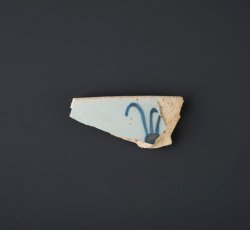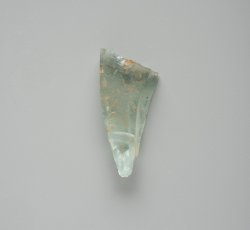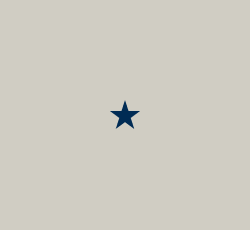Indeterminate - Page 7 of 12

Handpainted blue tin-glaze earthenware bowl.
Refined Earthenware | Object #: 1722749
This is a fragment of a tin-glazed earthenware bowl, or possibly small punch bowl, with a hand painted decorative band adorning the rim. This ware is often referred to by archaeologists as delftware. The white coloration of the glaze was obtained by adding tin-oxide to a lead glaze. Against thi...
Explore This Item
Tin-glaze earthenware holloware.
Refined Earthenware | Object #: 1722775
This is a fragment of an undecorated tin-glazed earthenware utilitarian hollow form, such as a chamber pot or large basin. This ware is often referred to by archaeologists as delftware. The white coloration of the glaze was obtained by adding tin-oxide to a lead glaze. Ceramics such as these we...
Explore This Item
Tin-glaze earthenware drug jar/ salve pot.
Refined Earthenware | Object #: 1722797
This is a fragment from the base of a tin-glazed earthenware drug jar. This ware is often referred to by archaeologists as delftware. The white coloration of the glaze was obtained by adding tin-oxide to a lead glaze. Against this white field, delft was most often decorated with hand painted co...
Explore This Item
Tin-glaze earthenware drug jar/ slave pot.
Refined Earthenware | Object #: 1722817
This is a fragment from a slightly flared pedestal base of a tin-glazed earthenware drug jar. This ware is often referred to by archaeologists as delftware. The white coloration of the glaze was obtained by adding tin-oxide to a lead glaze. Against this white field, delft was most often decorat...
Explore This Item
Handpainted blue tin-glaze earthenware plate or dish.
Refined Earthenware | Object #: 1722839
Very similar decoration to object 1722710.
Explore This Item
Green-glaze cream colored refined earthenware vessel, unid.
Refined Earthenware | Object #: 1723155
These fragments of thinly potted cream colored ceramic are too small to reliably identify as a particular form. One of the primary ceramics advancements of the mid-eighteenth century was the development of thinly potted cream colored ceramics. In the early 1740s, the same clays used for white s...
Explore This Item
Aqua pharmaceutical vial finish and neck.
Non-Lead | Object #: 1781896
Aqua glass pharmaceutical vial finish and neck.
Explore This Item
Light blue hollow ware glass with fleur de lis design.
Non-Lead | Object #: 1782216
This small fragment of glass is a part of a French perfume bottle and offers an intriguing story of international trade networks. Despite the slightly golden appearance caused by weathering effects, the color of this fragment was originally a dark blue, achieved by adding cobalt to molten glass...
Explore This Item
Molded unidentifiable aqua glass bottle.
Non-Lead | Object #: 1782404
Molded aqua bottle glass
Explore This Item
Silver-alloy plated copper alloy button face with stamped floral and geometric design.
Copper/Copper Alloy | Object #: 1785147
This is the metal face, or front portion, of a two piece button. In this style of button, a disk of lathed bone with a beveled edge often served as a button back. The face of the button was commonly fashioned from a sheet of thin metal, usually a variety of copper alloy, which would be crimped ...
Explore This Item
Amethyst glass sleeve button inlay with molded scalloped clam shell shape.
Glass | Object #: 1785932
This is a decorative glass inset which originally was set into the metal backing of a linked, or sleeve, button. Such insets are referred to as “pastes,” and could be colored, cut, or molded, and would have been set into metal backings. This example is an amethyst colored glass, which has been ...
Explore This Item
Pair of cast copper alloy sleeve buttons with link.
Copper/Copper Alloy | Object #: 1785993
This is a complete linked button, often referred to as a sleeve button. This example is made of cast copper alloy disks joined by a single link. Decoration could be formed through the casting process, or through engraving. In this example, the decorative elements consist of six large dots arran...
Explore This Item
Colorless leaded faceted glass sleeve button inlay
Glass | Object #: 1786094
This is a decorative glass inset which originally was set into the metal backing of a linked, or sleeve, button. Such insets are referred to as “pastes,” and could be colored, cut, or molded, and would have been set into metal backings. This example is a leaded colorless glass, which has been s...
Explore This Item
Colorless lead glass sleeve button inlay with molded coral branch design
Glass | Object #: 1787142
This is a decorative glass inset which originally was set into the metal backing of a linked, or sleeve, button. Such insets are referred to as “pastes,” and could be colored, cut, or molded, and would have been set into metal backings. This example is a molded, colorless, leaded glass. The dec...
Explore This Item
Colorless glass sleeve button inlay with molded 8-pointed star design
Glass | Object #: 1787157
This is a decorative glass inset which originally was set into the metal backing of a linked, or sleeve, button. Such insets are referred to as “pastes,” and could be colored, cut, or molded, and would have been set into metal backings. This example is a molded, colorless, leaded glass. The dec...
Explore This Item
Colorless glass sleeve button inlay with molded house, 2 trees, fence, and path.
Glass | Object #: 1787164
This is a decorative glass inset which originally was set into the metal backing of a linked, or sleeve, button. Such insets are referred to as “pastes,” and could be colored, cut, or molded, and would have been set into metal backings. This example is a molded, colorless, leaded glass. The dec...
Explore This Item
Faceted colorless glass inset sleeve button.
Copper/Copper Alloy | Object #: 1787193
Catalogued from drawing.
Explore This Item
Bone back to waist coat button with wire eye.
Bone | Object #: 1787213
Bone button molds were disks cut from animal bone, often identifiable by the presence of a single central hole created by a cutting tool during production. The bone disk often served as the back of a two part button. In this button form, the face of the button was commonly comprised of a stampe...
Explore This Item
Bone back to waist coat button with wire eye.
Bone | Object #: 1787433
Bone button molds were disks cut from animal bone, often identifiable by the presence of a single central hole created by a cutting tool during production. The bone disk often served as the back of a two part button. In this button form, the face of the button was commonly comprised of a stampe...
Explore This Item
Bone back to coat button with wire eye.
Bone | Object #: 1787434
Bone button molds were disks cut from animal bone, often identifiable by the presence of a single central hole created by a cutting tool during production. The bone disk often served as the back of a two part button. In this button form, the face of the button was commonly comprised of a stampe...
Explore This Item